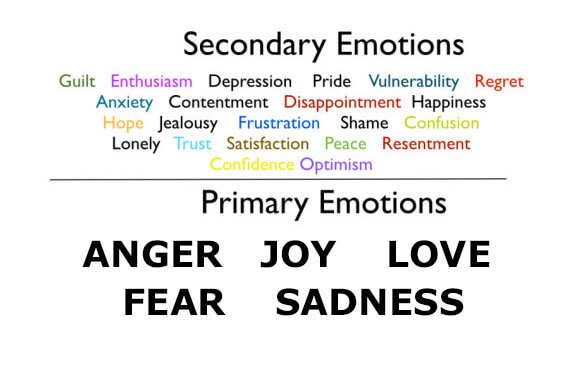Anger as a Primary and a Secondary Emotion

Primary emotions are emotions that we feel first, as a first automatic reaction to a situation. For example, if we are threatened, we may feel fear or anger. When we experience lose, we may feel sadness. Primary emotions are unthinking, instinctive responses that we have. We will typically see these in animals also, which confirms our suspicion that they have an evolutionary basis.
Secondary emotions are emotional reactions we have to other emotions. For example, a person may feel ashamed as a result of becoming anxious or angry. In this case, anxiety would be the primary emotion while shame would be the secondary emotion.
Anger arises for a variety of reasons. Only when you have determined the trigger factors and its real cause, then you will be able to deal with it in a suitable manner. When you discover the source of your anger and identify your need, you will find a way to address your anger appropriately.
Anger is one of the five 5 primary emotions (mad, sad, glad, fear, and disgust). Some people add the emotion of surprise to this list. These primary emotions are found in all human species as well as some “subhuman primates species,” (apes, monkeys etc.).
With the exceptions of glad and surprise, all of the primary emotions are primitive threat detectors which alert us to the presence of threat and prepare our bodies to deal with the threat. Similar to the smoke and heat detectors that exist in your house, each emotional threat detector reacts to a different type of threat.
Our emotional threat detectors were designed to protect our ancestors from physical harm. It was designed to keep us alive and serves as a survival mechanism. Yet, today it creates a new problem. While we still may encounter survival-based threats today, most of our threats that we experience are psychological threats. These are threats to our boundaries, our dignity, our respect, our values, our sense of right and wrong etc.
Some of the emotional responses that our ancestors developed to enable them to cope with their everyday situations can seem confusing when we experience them in our everyday situations, especially if we don’t understand their origins, or why they are triggered in particular situations.
This is why it is important to realize the original purpose of anger, its reactivity and then able to use it constructively. The usefulness of anger comes in being able to harness, master and direct it in a beneficial way, rather than acting on it impulsively. Your anger is a tool that you must learn to use and transform.
Mastering anger involves knowing what anger is (a primitive threat detector), knowing the message of anger (my need is blocked), and taking the time to assess the threat and need and accordingly and choose a response. Assessing the threat means you have to decide if the threat is real or is as a result of a false-positive (mistake in appraisal). If it is a genuine and relevant threat, you should use the motivation and the power of your anger to counter-attack the threat. In this case, anger serves as a primary emotion.
In other possibilities, anger can serve as a secondary emotion. In these cases, anger covers up other emotions. You are substituting your anger for other feelings such as sadness, hurt, or vulnerability or that you have misunderstood the actions of another and what appeared to be a threat is not a threat.
For example, the critical comments of your collogue that you received at work might not mean that they are a threat or lack of respect, but rather a difference of opinion to the best interest for the company, or they just did not know how to more appropriately communicate their ideas.
It is only when you identify that underlying experience and its corresponding response, that you can stop your explosions and channel your anger and redirect its focus on positivity and purpose. The constructive direction and momentum you develop will help you be a more producing and emotional balance.





